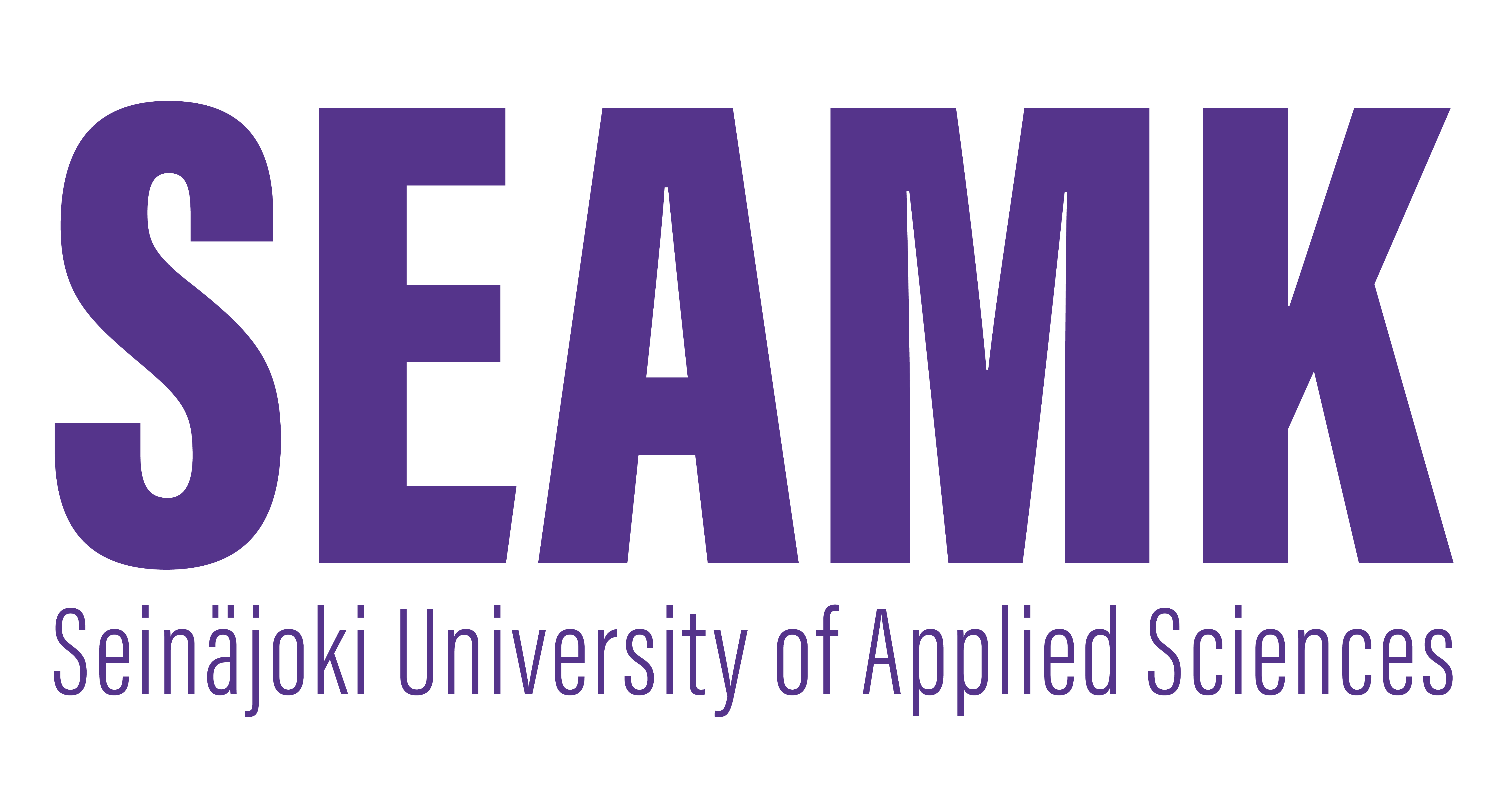Cultural well-being in social and health care services (5cr)
Code: BH00DE47-3003
General information
- Enrollment
- 01.08.2023 - 30.11.2023
- Registration for the implementation has ended.
- Timing
- 04.09.2023 - 31.12.2023
- Implementation has ended.
- Number of ECTS credits allocated
- 5 cr
- Local portion
- 0 cr
- Virtual portion
- 5 cr
- Mode of delivery
- Distance learning
- Campus
- SeAMK Seinäjoki, Kampustalo
- Teaching languages
- Finnish
- Degree programmes
- Master's Degree in Social Services and Health Care, Social Work
- Teachers
- Tiina Hautamäki
- Course
- BH00DE47
Evaluation scale
1-5
Objective
The student can explain cultural well-being as part in social and health care services and name goals and methods of cultural well-being. The goal is to study cultural well-being as part of organizing social and health care with different kind of clients. The student can evaluate cultural well-being as part of social and health care services. The student is familiar with the concept of cultural well-being and can present development proposals that can be used to support the well-being of people through culture. The goal is to develope sustainable cultural action that support clients´ well-being.
Content
The definition of cultural well-being.
The connection between culture and well-being.
Cultural well-being in different contexts and as part of social and health care services. Cultural well-being as part of work with individuals and participatory methods in social and health care.
Cultural well-being and sustainable development as part of services.
Promoting cultural well-being.
Materials
Kirjallisuutta esim.
Colliander, M. (2017). Kulttuuri ja taide hoivalaitoksissa. Laitosarjen ja kulttuuritoiminnan ideaalien kohtaamisia. Sosiologia, 54(3), 305-321.
https://trepo.tuni.fi/bitstream/handle/10024/102454/kulttuuri_ja_taide_hoivalaitoksessa.pdf?sequence=1&isAllowed=y
Haapoja, M-M. (2020). Moniammatillisesti tuotettu kulttuurihyvinvointi sosiaalialalla. Sosionomi AMK. Opinnäytetyö. Seinäjoen ammattikorkeakoulu.
https://urn.fi/URN:NBN:fi:amk-202003314257
Hautamäki, T., Saarela, J. & Kareinen, J. (2021). Konsertin live-striimaus yleisötyön uutena muotona – Seinäjoen kaupunginorkesterin EL TANGO konsertti välitettiin viiteen kylätaloon. SeAMK verkkolehti 17.11.2021. https://lehti.seamk.fi/hyvinvointi-ja-luovuus/konsertin-live-striimaus-yleisotyon-uutena-muotona-seinajoen-kaupunginorkesterin-el-tango-konsertti-valitettiin-viiteen-kylataloon/?
Houni P., Turpeinen I. & Vuolasto J. (2020). Taidetta! Kulttuurihyvinvoinnin käsikirja. Helsinki. Taiteen edistämiskeskus. https://www.taike.fi/fi/kulttuurihyvinvointikirja
Kulttuurihyvinvointisuunnitelma (2021). K65. Ikääntyvien kulttuurihyvinvointisuunnitelma 2021-2025. Seinäjoki. https://www.seinajoki.fi/wp-content/uploads/2021/05/K65-Kulttuurihyvinvointisuunnitelma-DIGI.pdf
Laitinen, L. (2017). Näkökulmia taiteen ja kulttuurin sosiaalisen hyvinvoinnin vaikutuksiin. Sitra. https://www.sitra.fi/artikkelit/nakokulmia-taiteen-ja-kulttuurin-sosiaalisen-hyvinvoinnin-vaikutuksiin/
Laitinen, L. (2017). Näkökulmia taiteen ja kulttuurin terveysvaikutuksiin. Sitra. https://www.sitra.fi/artikkelit/nakokulmia-taiteen-ja-kulttuurin-terveysvaikutuksiin/
Ojanen, S. (2022). Etsimässä senioripalveluiden kulttuuri- ja taidelähtöistä näkökulmaa digitalisaation keskellä. Opinnäytetyö. Kulttuurituottaja (ylempi AMK). Seinäjoen ammattikorkeakoulu. http://www.theseus.fi/handle/10024/746428
Rautiainen-Keskustalo, T. (2021). Embodiment through digital intangibility: infrastructure of musicking. Journal of New Music Research, 50:2, 147-154. https://doi.org/10.1080/09298215.2021.1899248
Rosenlöf, A-M. (2014). Rakenteita ratkomassa. Kulttuurisen seniori- ja vanhustyön käytäntöjä ja toimintamalleja. Taiteen edistämiskeskus. https://www.taike.fi/documents/11580/137239/
Sandbäck Forsell, J., Koskinen, C. & Nyholm, L. (2022). Caring as temporal turns in life through creative writing. Nordic Journal of Arts, Culture and Health. Vol. 4, nr. 1-2022, s.1-11.
https://www.idunn.no/doi/epdf/10.18261/njach.4.1.7
STM (2015). Taiteesta ja kulttuurista hyvinvointia. Toimintaohjelman 2010-2014 loppuraportti. Sosiaali- ja terveysministeriön raportteja ja muistioita 2015:17.
https://julkaisut.valtioneuvosto.fi/handle/10024/70355
Sorjonen, H., Sivonen, O. (2015). Taide- ja kulttuurilaitosten yleisötyön muodot, laajuus ja tuloksellisuus. Cuporen verkkojulkaisuja 27. https://www.cupore.fi/fi/julkaisut/cuporen-julkaisut/hilppa-sorjonen-ja-outi-sivonen-taide-ja-kulttuurilaitosten-yleisotyon-muodot-laajuus-ja-tuloksellisuus
Taikusydän https://taikusydan.turkuamk.fi/
Vaasan kaupunki (2020). Onnistu etätuokioissa. Virtuaalisen kulttuuripalvelun opas. https://www.vaasa.fi/uploads/2020/09/0612688e-virtuaalisen-kulttuuripalvelun-opas.pdf
Vaasan kaupunki (2020). Iloa elämään virtuaalisilla kulttuuripalveluilla. Virtaa monitaidehanke raportti 1.1.2020-30.9.2020.
https://www.vaasa.fi/uploads/2020/10/b1b01134-virtaa-monitaidehanke_raportti.pdf
WHO (2017). Culture matters: using a cultural contexts of health approach to enhance policy making. Ed. Napier D.A. Policy brief, no. 1.
https://www.euro.who.int/__data/assets/pdf_file/0009/334269/14780_World-Health-Organisation_Context-of-Health_TEXT-AW-WEB.pdf
WHO (2022). Can culture bring new meaning to waste. News 1.6.2022.
https://www.who.int/europe/news/item/01-06-2022-can-culture-bring-new-meaning-to-waste
Teaching methods
Virtuaalitoteutus
Student workload
5 op opiskelijan itsenäistä opiskelua
Assessment criteria, satisfactory (1)
The student recognizes role and discussions of cultural well-being. The student can name goals, tools and methods of cultural well-being for developing social and health care services. The student is familiar with the concept of cultural well-being.
Assessment criteria, good (3)
The student can describe role and discussions of cultural well-being. The student can adapt goals, tools and methods of cultural well-being for developing social and health care services. The student is familiar with the concept of cultural well-being and presents development proposals that can be used to support the well-being of people through culture.
Assessment criteria, excellent (5)
The student can analytically and critically describe role and discussions of cultural well-being. The student can analytically adapt goals, tools and methods of cultural well-being for developing social and health care services. The student is familiar with the concept of cultural well-being and presents innovative proposals that can be used to support the well-being of people through culture.
